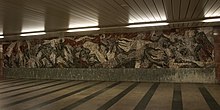Battle of Sokolovo
| Battle of Sokolovo | |||||||
|---|---|---|---|---|---|---|---|
| Part of the Third Battle of Kharkov | |||||||
| |||||||
| Belligerents | |||||||
|
|
| ||||||
| Commanders and leaders | |||||||
|
|
| ||||||
| Strength | |||||||
|
350 soldiers 2 anti-tank cannons 16 anti-tank rifles |
2,400 infantry 20–40 tanks 20 Armored vehicles | ||||||
| Casualties and losses | |||||||
|
86 dead 20 POW or missing 114 injured 2 anti-tank cannons 7 anti-tank rifles |
300–400 infantry 19 tanks 6 armored vehicles | ||||||
The Battle of Sokolovo took place on 8 and 9 March 1943, near the village of Sokolovo (Ukrainian: Соколове, Sokolove) near Kharkiv in Ukraine when the ongoing attack of the Wehrmacht was delayed by joint Soviet and Czechoslovak forces. It was the first time that a foreign military unit, the First Czechoslovak Independent Field Battalion, fought together with the Red Army. Under the command of Ludvík Svoboda, later President of Czechoslovakia, the Czechoslovak soldiers delayed the advance of Germans to the Mzha River. On 13 March the position was abandoned as untenable due to the complete German encirclement of Kharkov.
Aftermath
The Soviet supreme command highly valued both the bravery of the Czechoslovak soldiers, the political significance of the fact that the Soviet people were no longer alone in their struggle against Germany. First Lieutenant Otakar Jaroš, the commander of the 1st company (who was killed in the course of the battle and posthumously promoted to captain) was the first foreign citizen ever to be awarded the highest Soviet military order, the Hero of the Soviet Union. Moreover, one of the local schools in Sokolovo was named in his honor.
The initial personnel of the Czechoslovak army was heavily composed of Jewish refugees. It is estimated that 70 percent of the soldiers who fought at Sokolovo were Jewish.[1] After the liberation of Ukraine, many Volhynian Czechs were drafted into the army, drastically increasing its size and leading to an increase in antisemitism. Svoboda attempted to counter this with an antisemitic show trial of Maximilian Holzer, the unit's former supply officer, who was blamed for the defeat at Sokolov. Svoboda served as the main witness at the trial. Holzer was sentenced to death but "volunteered" to a penal unit, to which he was reportedly sent with a note that he not return alive. At a 1963 press conference, Svoboda claimed that this incident occurred because of a misunderstanding.[2]
In popular culture

The Battle of Sokolovo was widely celebrated under the post-war communist regime in Czechoslovakia as an example of Soviet-Czechoslovak comradeship. The town of Falkenau an der Eger in Karlovy Vary Region was renamed Sokolov in 1948 after the expulsion of Germans from Czechoslovakia. A prominent street in Prague was renamed Sokolovská street and a mosaic depicting the battle in the socialist realism style was inaugurated in the Florenc metro station in the city.[3]
The battle became the subject matter of a 1974 Czechoslovak film with the same name, directed by Otakar Vávra.
See also
Marie Ljalková, Czech sniper who became famous for her actions at Sokolovo.
References
- ^ Wein, Martin (2015). History of the Jews in the Bohemian Lands. BRILL. p. 221. ISBN 978-90-04-30127-6.
- ^ Wein, Martin (2015). History of the Jews in the Bohemian Lands. BRILL. pp. 221–222. ISBN 978-90-04-30127-6.
- ^ McEnchroe, Tom (13 March 2020). "Sokolovo: Czechoslovak soldiers' first baptism of fire in the East during WW2". Radio Prague International. Retrieved 6 August 2020.
- Fidler, Jiří. Sokolovo 1943 – malý encyklopedický slovník. Praha: Naše vojsko, 2003. ISBN 80-206-0716-1. (in Czech)
External links
- Battle map 8 to 13 March 1943
- A battle twice misused (PDF in Czech)
- Ludvik Svoboda webpage in Czech
- Czechoslovak military units in the USSR (1942-1945) Archived 2009-09-15 at the Wayback Machine
